Stakeholder Management at Snap Inc.
VerifiedAdded on 2023/06/05
|16
|3185
|119
AI Summary
This report analyzes the stakeholder management at Snap Inc. and includes a stakeholder map, stakeholder analysis, and strategic programs for stakeholders. The report also provides recommendations for better stakeholder management. The main stakeholders identified are employees, management, customers, and society.
Contribute Materials
Your contribution can guide someone’s learning journey. Share your
documents today.

Running head: STAKEHOLDER MANAGEMENT
Stakeholder management
Name of the student:
Name of the university:
Author note:
Stakeholder management
Name of the student:
Name of the university:
Author note:
Secure Best Marks with AI Grader
Need help grading? Try our AI Grader for instant feedback on your assignments.
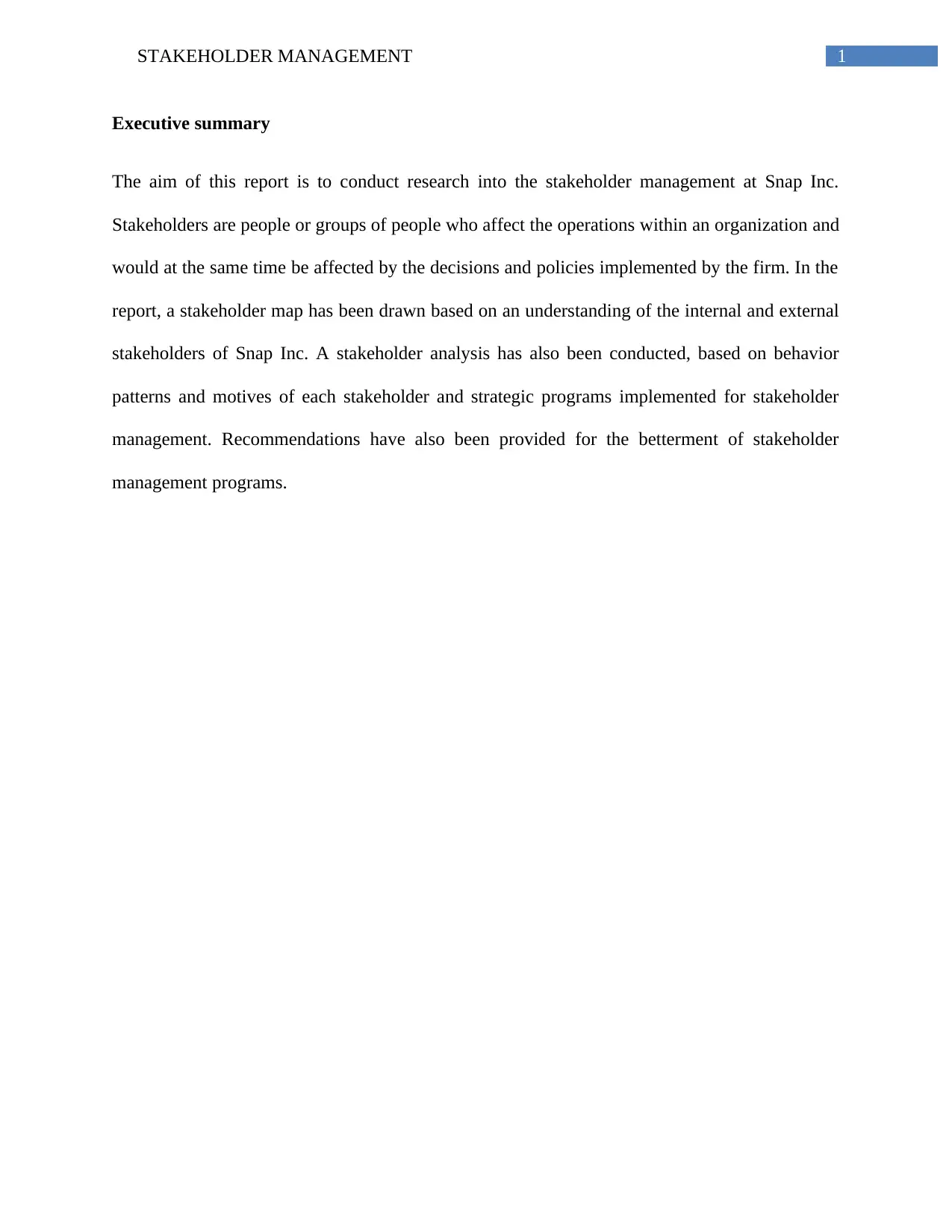
1STAKEHOLDER MANAGEMENT
Executive summary
The aim of this report is to conduct research into the stakeholder management at Snap Inc.
Stakeholders are people or groups of people who affect the operations within an organization and
would at the same time be affected by the decisions and policies implemented by the firm. In the
report, a stakeholder map has been drawn based on an understanding of the internal and external
stakeholders of Snap Inc. A stakeholder analysis has also been conducted, based on behavior
patterns and motives of each stakeholder and strategic programs implemented for stakeholder
management. Recommendations have also been provided for the betterment of stakeholder
management programs.
Executive summary
The aim of this report is to conduct research into the stakeholder management at Snap Inc.
Stakeholders are people or groups of people who affect the operations within an organization and
would at the same time be affected by the decisions and policies implemented by the firm. In the
report, a stakeholder map has been drawn based on an understanding of the internal and external
stakeholders of Snap Inc. A stakeholder analysis has also been conducted, based on behavior
patterns and motives of each stakeholder and strategic programs implemented for stakeholder
management. Recommendations have also been provided for the betterment of stakeholder
management programs.
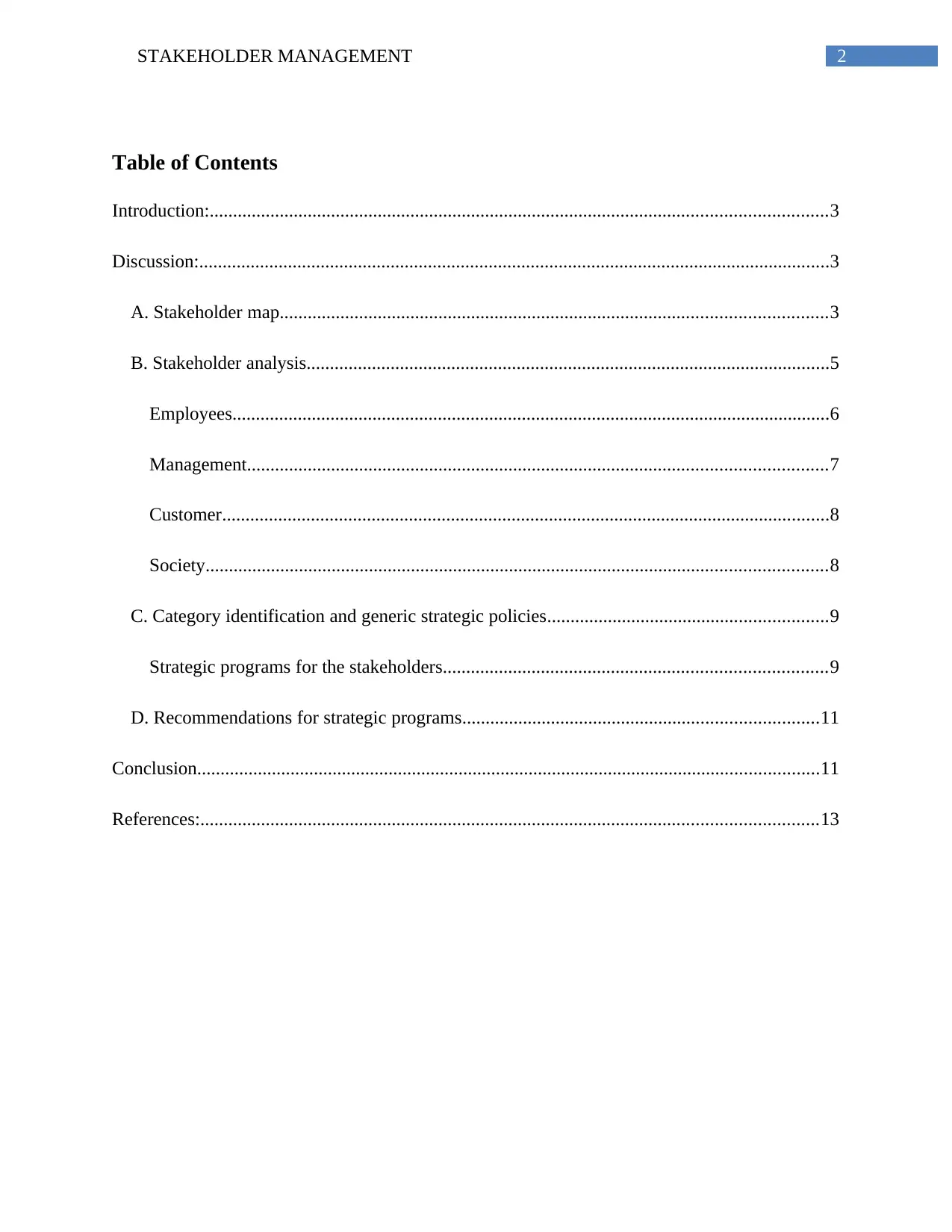
2STAKEHOLDER MANAGEMENT
Table of Contents
Introduction:....................................................................................................................................3
Discussion:.......................................................................................................................................3
A. Stakeholder map.....................................................................................................................3
B. Stakeholder analysis................................................................................................................5
Employees................................................................................................................................6
Management............................................................................................................................7
Customer..................................................................................................................................8
Society.....................................................................................................................................8
C. Category identification and generic strategic policies............................................................9
Strategic programs for the stakeholders..................................................................................9
D. Recommendations for strategic programs............................................................................11
Conclusion.....................................................................................................................................11
References:....................................................................................................................................13
Table of Contents
Introduction:....................................................................................................................................3
Discussion:.......................................................................................................................................3
A. Stakeholder map.....................................................................................................................3
B. Stakeholder analysis................................................................................................................5
Employees................................................................................................................................6
Management............................................................................................................................7
Customer..................................................................................................................................8
Society.....................................................................................................................................8
C. Category identification and generic strategic policies............................................................9
Strategic programs for the stakeholders..................................................................................9
D. Recommendations for strategic programs............................................................................11
Conclusion.....................................................................................................................................11
References:....................................................................................................................................13
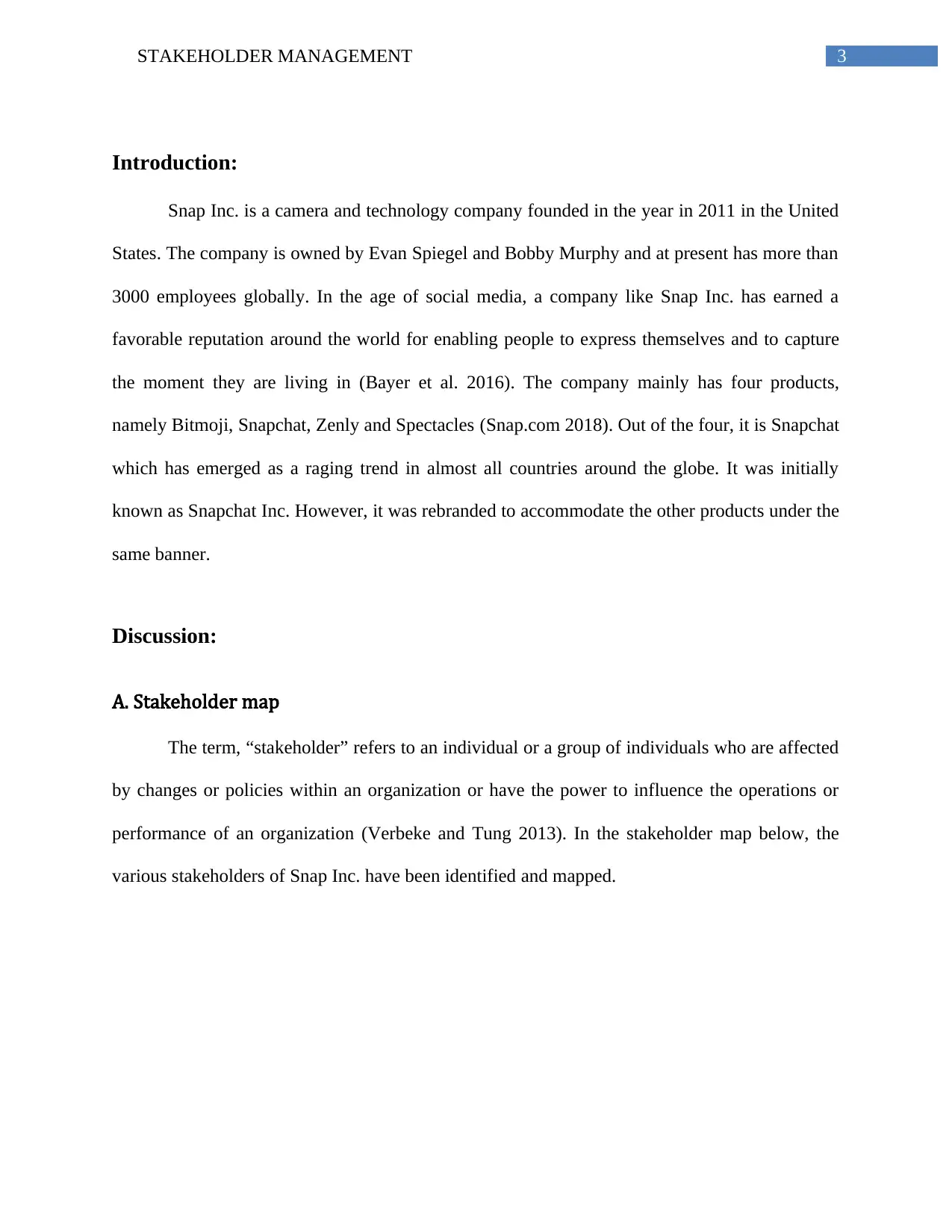
3STAKEHOLDER MANAGEMENT
Introduction:
Snap Inc. is a camera and technology company founded in the year in 2011 in the United
States. The company is owned by Evan Spiegel and Bobby Murphy and at present has more than
3000 employees globally. In the age of social media, a company like Snap Inc. has earned a
favorable reputation around the world for enabling people to express themselves and to capture
the moment they are living in (Bayer et al. 2016). The company mainly has four products,
namely Bitmoji, Snapchat, Zenly and Spectacles (Snap.com 2018). Out of the four, it is Snapchat
which has emerged as a raging trend in almost all countries around the globe. It was initially
known as Snapchat Inc. However, it was rebranded to accommodate the other products under the
same banner.
Discussion:
A. Stakeholder map
The term, “stakeholder” refers to an individual or a group of individuals who are affected
by changes or policies within an organization or have the power to influence the operations or
performance of an organization (Verbeke and Tung 2013). In the stakeholder map below, the
various stakeholders of Snap Inc. have been identified and mapped.
Introduction:
Snap Inc. is a camera and technology company founded in the year in 2011 in the United
States. The company is owned by Evan Spiegel and Bobby Murphy and at present has more than
3000 employees globally. In the age of social media, a company like Snap Inc. has earned a
favorable reputation around the world for enabling people to express themselves and to capture
the moment they are living in (Bayer et al. 2016). The company mainly has four products,
namely Bitmoji, Snapchat, Zenly and Spectacles (Snap.com 2018). Out of the four, it is Snapchat
which has emerged as a raging trend in almost all countries around the globe. It was initially
known as Snapchat Inc. However, it was rebranded to accommodate the other products under the
same banner.
Discussion:
A. Stakeholder map
The term, “stakeholder” refers to an individual or a group of individuals who are affected
by changes or policies within an organization or have the power to influence the operations or
performance of an organization (Verbeke and Tung 2013). In the stakeholder map below, the
various stakeholders of Snap Inc. have been identified and mapped.
Secure Best Marks with AI Grader
Need help grading? Try our AI Grader for instant feedback on your assignments.
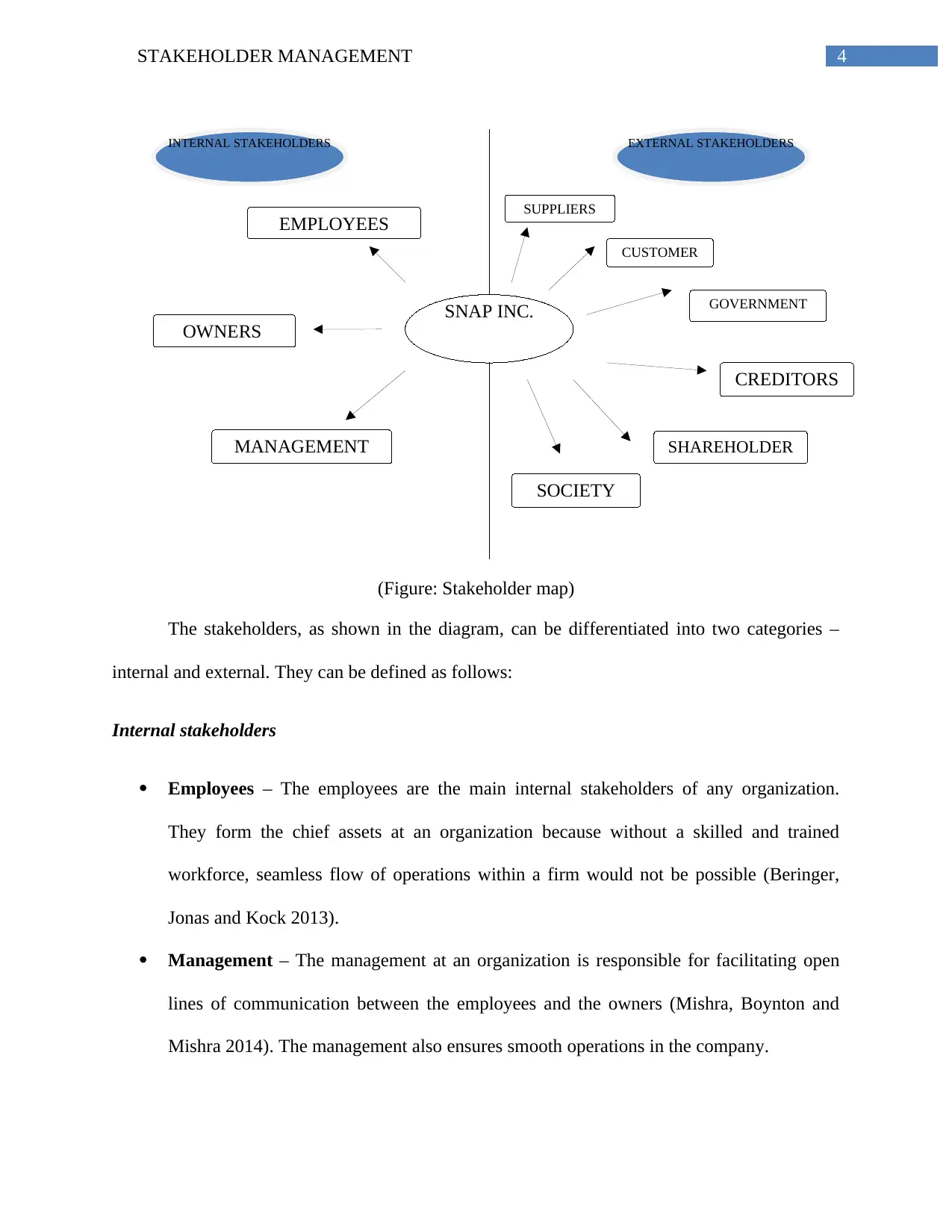
4STAKEHOLDER MANAGEMENT
SNAP INC.
EMPLOYEES
OWNERS
MANAGEMENT
SUPPLIERS
CUSTOMER
GOVERNMENT
CREDITORS
SHAREHOLDER
SOCIETY
INTERNAL STAKEHOLDERS EXTERNAL STAKEHOLDERS
(Figure: Stakeholder map)
The stakeholders, as shown in the diagram, can be differentiated into two categories –
internal and external. They can be defined as follows:
Internal stakeholders
Employees – The employees are the main internal stakeholders of any organization.
They form the chief assets at an organization because without a skilled and trained
workforce, seamless flow of operations within a firm would not be possible (Beringer,
Jonas and Kock 2013).
Management – The management at an organization is responsible for facilitating open
lines of communication between the employees and the owners (Mishra, Boynton and
Mishra 2014). The management also ensures smooth operations in the company.
SNAP INC.
EMPLOYEES
OWNERS
MANAGEMENT
SUPPLIERS
CUSTOMER
GOVERNMENT
CREDITORS
SHAREHOLDER
SOCIETY
INTERNAL STAKEHOLDERS EXTERNAL STAKEHOLDERS
(Figure: Stakeholder map)
The stakeholders, as shown in the diagram, can be differentiated into two categories –
internal and external. They can be defined as follows:
Internal stakeholders
Employees – The employees are the main internal stakeholders of any organization.
They form the chief assets at an organization because without a skilled and trained
workforce, seamless flow of operations within a firm would not be possible (Beringer,
Jonas and Kock 2013).
Management – The management at an organization is responsible for facilitating open
lines of communication between the employees and the owners (Mishra, Boynton and
Mishra 2014). The management also ensures smooth operations in the company.
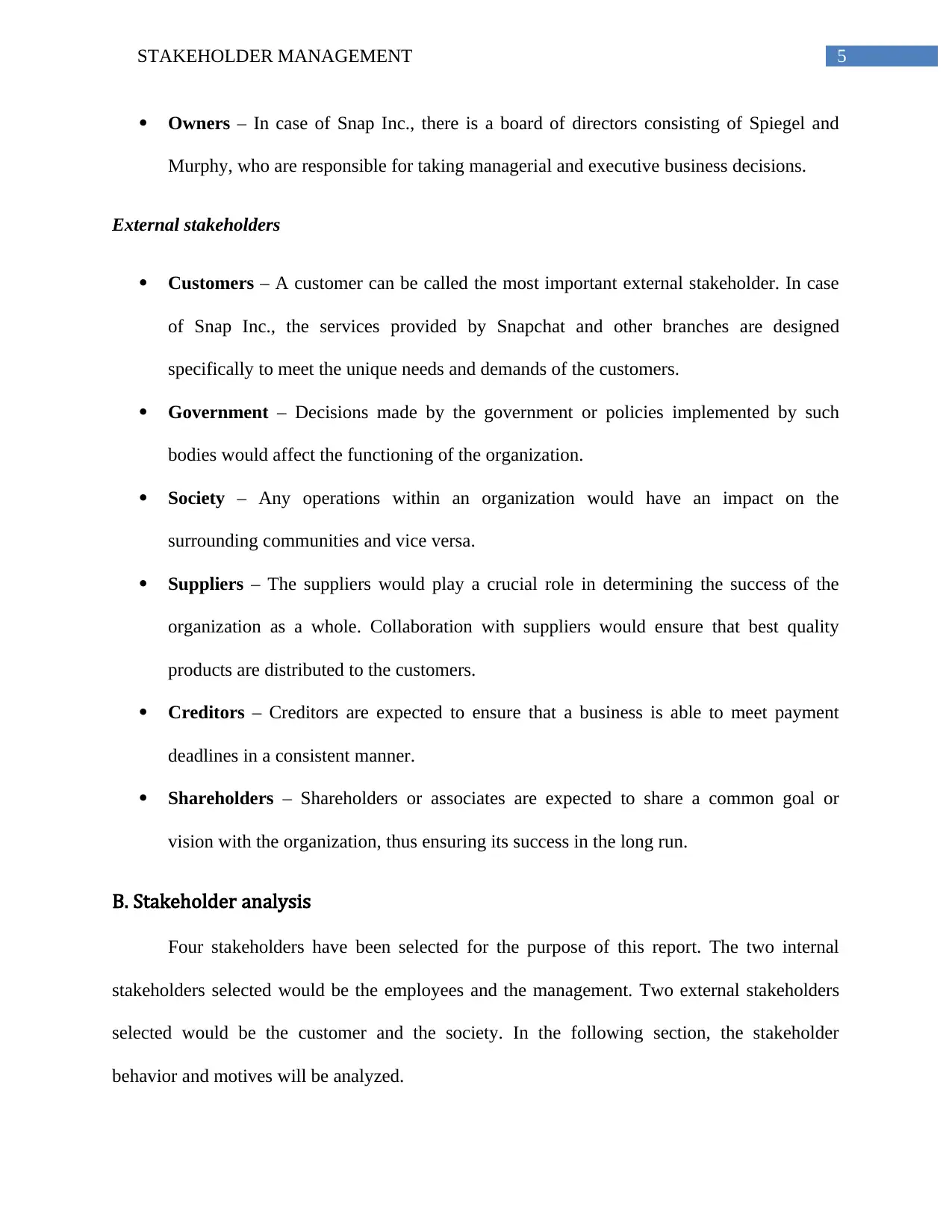
5STAKEHOLDER MANAGEMENT
Owners – In case of Snap Inc., there is a board of directors consisting of Spiegel and
Murphy, who are responsible for taking managerial and executive business decisions.
External stakeholders
Customers – A customer can be called the most important external stakeholder. In case
of Snap Inc., the services provided by Snapchat and other branches are designed
specifically to meet the unique needs and demands of the customers.
Government – Decisions made by the government or policies implemented by such
bodies would affect the functioning of the organization.
Society – Any operations within an organization would have an impact on the
surrounding communities and vice versa.
Suppliers – The suppliers would play a crucial role in determining the success of the
organization as a whole. Collaboration with suppliers would ensure that best quality
products are distributed to the customers.
Creditors – Creditors are expected to ensure that a business is able to meet payment
deadlines in a consistent manner.
Shareholders – Shareholders or associates are expected to share a common goal or
vision with the organization, thus ensuring its success in the long run.
B. Stakeholder analysis
Four stakeholders have been selected for the purpose of this report. The two internal
stakeholders selected would be the employees and the management. Two external stakeholders
selected would be the customer and the society. In the following section, the stakeholder
behavior and motives will be analyzed.
Owners – In case of Snap Inc., there is a board of directors consisting of Spiegel and
Murphy, who are responsible for taking managerial and executive business decisions.
External stakeholders
Customers – A customer can be called the most important external stakeholder. In case
of Snap Inc., the services provided by Snapchat and other branches are designed
specifically to meet the unique needs and demands of the customers.
Government – Decisions made by the government or policies implemented by such
bodies would affect the functioning of the organization.
Society – Any operations within an organization would have an impact on the
surrounding communities and vice versa.
Suppliers – The suppliers would play a crucial role in determining the success of the
organization as a whole. Collaboration with suppliers would ensure that best quality
products are distributed to the customers.
Creditors – Creditors are expected to ensure that a business is able to meet payment
deadlines in a consistent manner.
Shareholders – Shareholders or associates are expected to share a common goal or
vision with the organization, thus ensuring its success in the long run.
B. Stakeholder analysis
Four stakeholders have been selected for the purpose of this report. The two internal
stakeholders selected would be the employees and the management. Two external stakeholders
selected would be the customer and the society. In the following section, the stakeholder
behavior and motives will be analyzed.
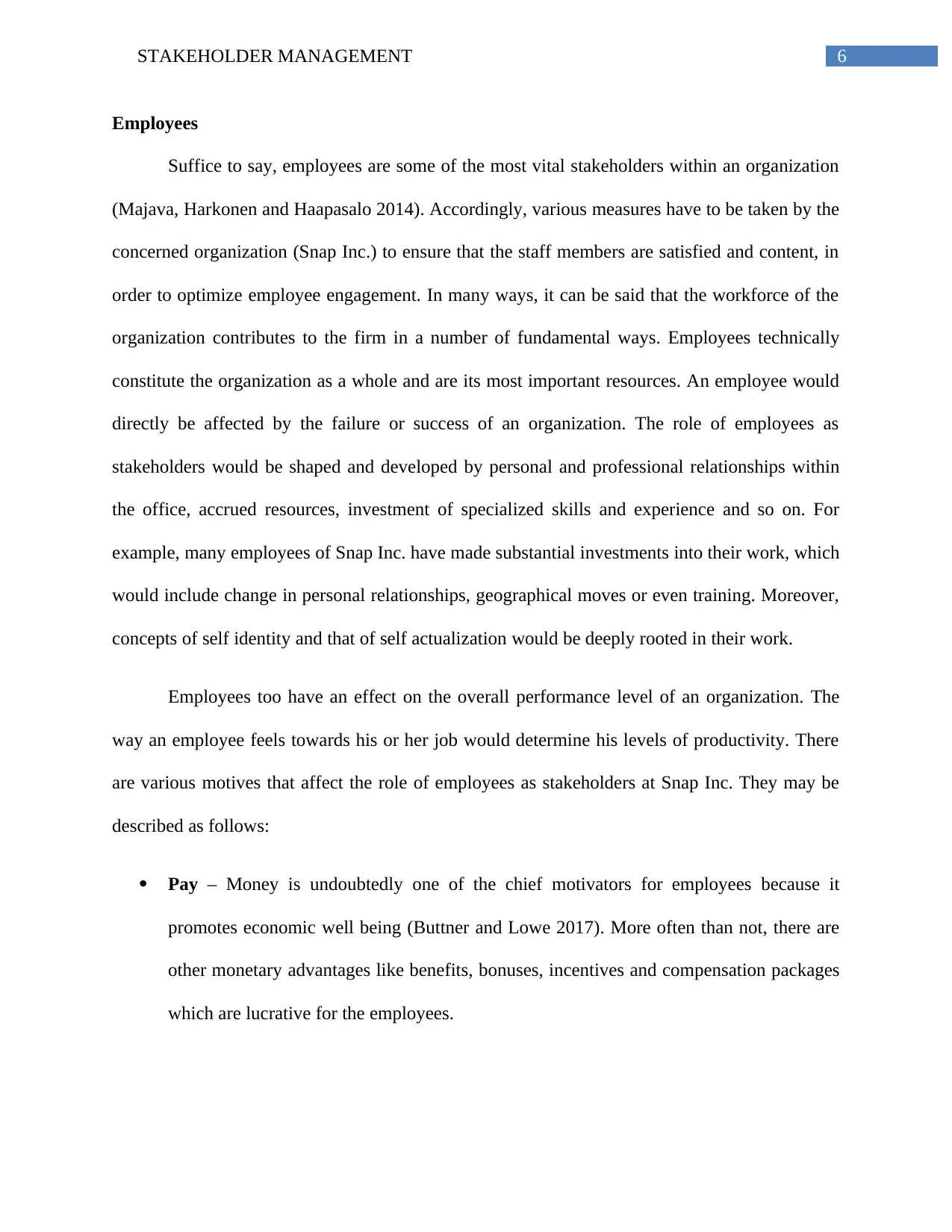
6STAKEHOLDER MANAGEMENT
Employees
Suffice to say, employees are some of the most vital stakeholders within an organization
(Majava, Harkonen and Haapasalo 2014). Accordingly, various measures have to be taken by the
concerned organization (Snap Inc.) to ensure that the staff members are satisfied and content, in
order to optimize employee engagement. In many ways, it can be said that the workforce of the
organization contributes to the firm in a number of fundamental ways. Employees technically
constitute the organization as a whole and are its most important resources. An employee would
directly be affected by the failure or success of an organization. The role of employees as
stakeholders would be shaped and developed by personal and professional relationships within
the office, accrued resources, investment of specialized skills and experience and so on. For
example, many employees of Snap Inc. have made substantial investments into their work, which
would include change in personal relationships, geographical moves or even training. Moreover,
concepts of self identity and that of self actualization would be deeply rooted in their work.
Employees too have an effect on the overall performance level of an organization. The
way an employee feels towards his or her job would determine his levels of productivity. There
are various motives that affect the role of employees as stakeholders at Snap Inc. They may be
described as follows:
Pay – Money is undoubtedly one of the chief motivators for employees because it
promotes economic well being (Buttner and Lowe 2017). More often than not, there are
other monetary advantages like benefits, bonuses, incentives and compensation packages
which are lucrative for the employees.
Employees
Suffice to say, employees are some of the most vital stakeholders within an organization
(Majava, Harkonen and Haapasalo 2014). Accordingly, various measures have to be taken by the
concerned organization (Snap Inc.) to ensure that the staff members are satisfied and content, in
order to optimize employee engagement. In many ways, it can be said that the workforce of the
organization contributes to the firm in a number of fundamental ways. Employees technically
constitute the organization as a whole and are its most important resources. An employee would
directly be affected by the failure or success of an organization. The role of employees as
stakeholders would be shaped and developed by personal and professional relationships within
the office, accrued resources, investment of specialized skills and experience and so on. For
example, many employees of Snap Inc. have made substantial investments into their work, which
would include change in personal relationships, geographical moves or even training. Moreover,
concepts of self identity and that of self actualization would be deeply rooted in their work.
Employees too have an effect on the overall performance level of an organization. The
way an employee feels towards his or her job would determine his levels of productivity. There
are various motives that affect the role of employees as stakeholders at Snap Inc. They may be
described as follows:
Pay – Money is undoubtedly one of the chief motivators for employees because it
promotes economic well being (Buttner and Lowe 2017). More often than not, there are
other monetary advantages like benefits, bonuses, incentives and compensation packages
which are lucrative for the employees.
Paraphrase This Document
Need a fresh take? Get an instant paraphrase of this document with our AI Paraphraser
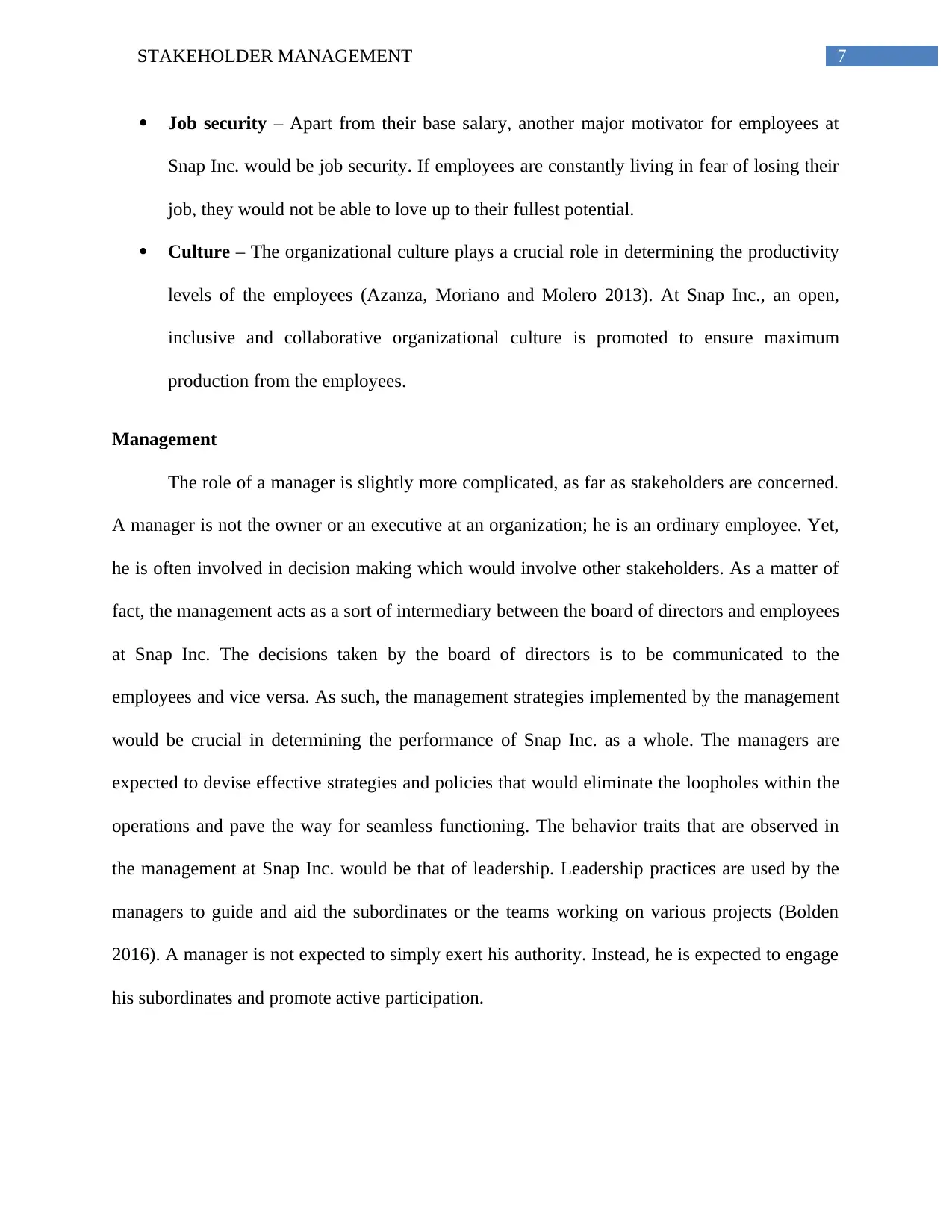
7STAKEHOLDER MANAGEMENT
Job security – Apart from their base salary, another major motivator for employees at
Snap Inc. would be job security. If employees are constantly living in fear of losing their
job, they would not be able to love up to their fullest potential.
Culture – The organizational culture plays a crucial role in determining the productivity
levels of the employees (Azanza, Moriano and Molero 2013). At Snap Inc., an open,
inclusive and collaborative organizational culture is promoted to ensure maximum
production from the employees.
Management
The role of a manager is slightly more complicated, as far as stakeholders are concerned.
A manager is not the owner or an executive at an organization; he is an ordinary employee. Yet,
he is often involved in decision making which would involve other stakeholders. As a matter of
fact, the management acts as a sort of intermediary between the board of directors and employees
at Snap Inc. The decisions taken by the board of directors is to be communicated to the
employees and vice versa. As such, the management strategies implemented by the management
would be crucial in determining the performance of Snap Inc. as a whole. The managers are
expected to devise effective strategies and policies that would eliminate the loopholes within the
operations and pave the way for seamless functioning. The behavior traits that are observed in
the management at Snap Inc. would be that of leadership. Leadership practices are used by the
managers to guide and aid the subordinates or the teams working on various projects (Bolden
2016). A manager is not expected to simply exert his authority. Instead, he is expected to engage
his subordinates and promote active participation.
Job security – Apart from their base salary, another major motivator for employees at
Snap Inc. would be job security. If employees are constantly living in fear of losing their
job, they would not be able to love up to their fullest potential.
Culture – The organizational culture plays a crucial role in determining the productivity
levels of the employees (Azanza, Moriano and Molero 2013). At Snap Inc., an open,
inclusive and collaborative organizational culture is promoted to ensure maximum
production from the employees.
Management
The role of a manager is slightly more complicated, as far as stakeholders are concerned.
A manager is not the owner or an executive at an organization; he is an ordinary employee. Yet,
he is often involved in decision making which would involve other stakeholders. As a matter of
fact, the management acts as a sort of intermediary between the board of directors and employees
at Snap Inc. The decisions taken by the board of directors is to be communicated to the
employees and vice versa. As such, the management strategies implemented by the management
would be crucial in determining the performance of Snap Inc. as a whole. The managers are
expected to devise effective strategies and policies that would eliminate the loopholes within the
operations and pave the way for seamless functioning. The behavior traits that are observed in
the management at Snap Inc. would be that of leadership. Leadership practices are used by the
managers to guide and aid the subordinates or the teams working on various projects (Bolden
2016). A manager is not expected to simply exert his authority. Instead, he is expected to engage
his subordinates and promote active participation.
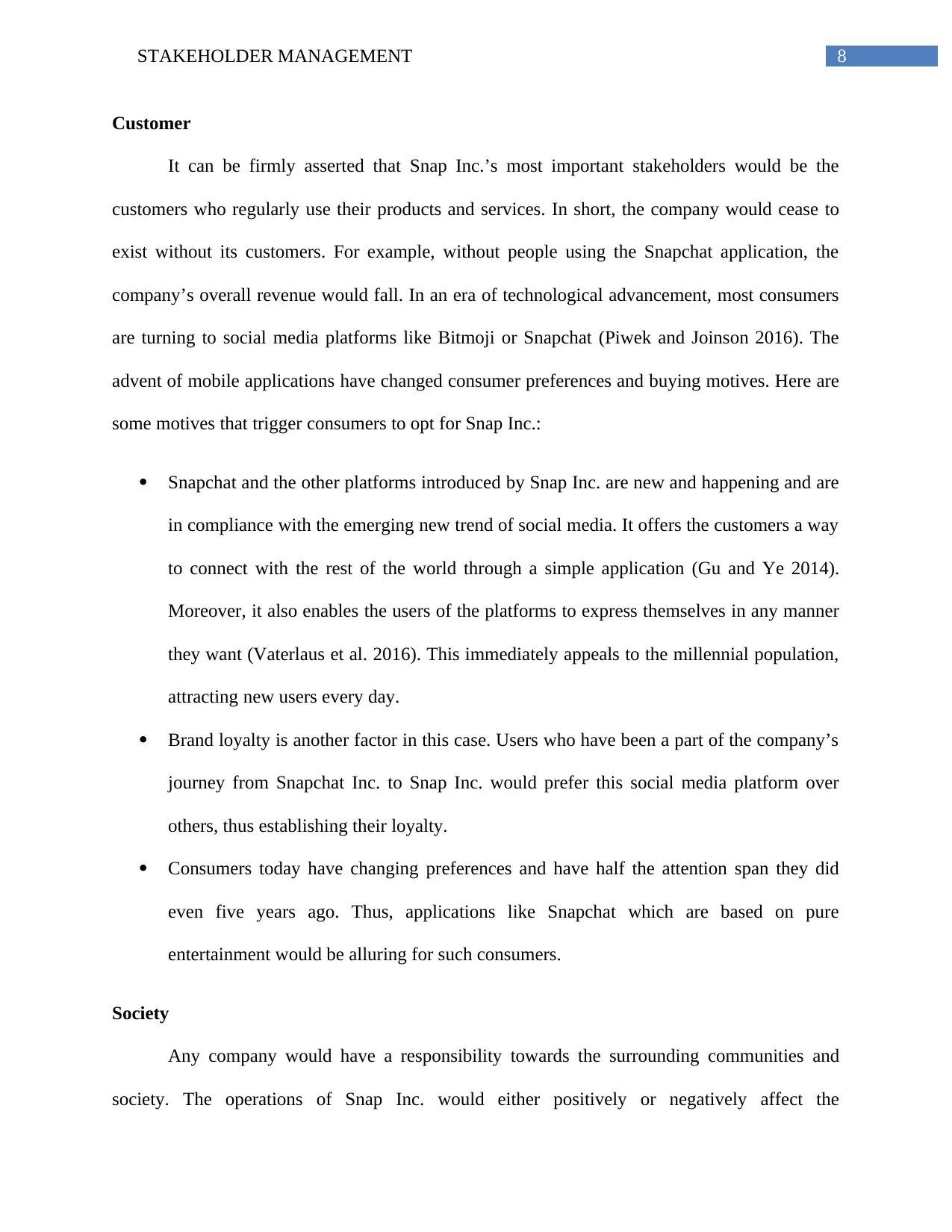
8STAKEHOLDER MANAGEMENT
Customer
It can be firmly asserted that Snap Inc.’s most important stakeholders would be the
customers who regularly use their products and services. In short, the company would cease to
exist without its customers. For example, without people using the Snapchat application, the
company’s overall revenue would fall. In an era of technological advancement, most consumers
are turning to social media platforms like Bitmoji or Snapchat (Piwek and Joinson 2016). The
advent of mobile applications have changed consumer preferences and buying motives. Here are
some motives that trigger consumers to opt for Snap Inc.:
Snapchat and the other platforms introduced by Snap Inc. are new and happening and are
in compliance with the emerging new trend of social media. It offers the customers a way
to connect with the rest of the world through a simple application (Gu and Ye 2014).
Moreover, it also enables the users of the platforms to express themselves in any manner
they want (Vaterlaus et al. 2016). This immediately appeals to the millennial population,
attracting new users every day.
Brand loyalty is another factor in this case. Users who have been a part of the company’s
journey from Snapchat Inc. to Snap Inc. would prefer this social media platform over
others, thus establishing their loyalty.
Consumers today have changing preferences and have half the attention span they did
even five years ago. Thus, applications like Snapchat which are based on pure
entertainment would be alluring for such consumers.
Society
Any company would have a responsibility towards the surrounding communities and
society. The operations of Snap Inc. would either positively or negatively affect the
Customer
It can be firmly asserted that Snap Inc.’s most important stakeholders would be the
customers who regularly use their products and services. In short, the company would cease to
exist without its customers. For example, without people using the Snapchat application, the
company’s overall revenue would fall. In an era of technological advancement, most consumers
are turning to social media platforms like Bitmoji or Snapchat (Piwek and Joinson 2016). The
advent of mobile applications have changed consumer preferences and buying motives. Here are
some motives that trigger consumers to opt for Snap Inc.:
Snapchat and the other platforms introduced by Snap Inc. are new and happening and are
in compliance with the emerging new trend of social media. It offers the customers a way
to connect with the rest of the world through a simple application (Gu and Ye 2014).
Moreover, it also enables the users of the platforms to express themselves in any manner
they want (Vaterlaus et al. 2016). This immediately appeals to the millennial population,
attracting new users every day.
Brand loyalty is another factor in this case. Users who have been a part of the company’s
journey from Snapchat Inc. to Snap Inc. would prefer this social media platform over
others, thus establishing their loyalty.
Consumers today have changing preferences and have half the attention span they did
even five years ago. Thus, applications like Snapchat which are based on pure
entertainment would be alluring for such consumers.
Society
Any company would have a responsibility towards the surrounding communities and
society. The operations of Snap Inc. would either positively or negatively affect the

9STAKEHOLDER MANAGEMENT
communities. Similarly, cultural values, traditions, beliefs and the attitudes of people in the
neighboring communities would have an impact on the mode of operations at the organization.
Community stakeholders would involve people, organizations and groups who have an interest
in the community and would stand to be affected by the objectives, policies and actions of the
company.
Communities would prefer to support organizations that affect their people in a positive
way. For example, applications and software like Snapchat and Bitmoji are widely used
in communities around the world, thus proving the permeating influence of social media
(Saxton and Waters 2014).
The environmental impacts of Snap Inc.’s operations also need to be taken into account.
The company’s corporate social responsibility would determine the attitude of the
surrounding communities towards the firm (Saeidi et al. 2015).
C. Category identification and generic strategic policies
The four stakeholders in the above section can be segregated into two categories –
internal and external stakeholders (Pinheiro 2015). The employees and the management form the
internal stakeholders of the company whereas the customers and the society form the external
stakeholders of the company.
Strategic programs for the stakeholders
Employees - Snap Inc. has a very basic and straightforward strategic program for
employee management. The CEO and the board of members ensure a top secret policy is
followed within the organization. The employees are updated about the goals and the
aims of the business and their operations are aligned with the business objectives. There
communities. Similarly, cultural values, traditions, beliefs and the attitudes of people in the
neighboring communities would have an impact on the mode of operations at the organization.
Community stakeholders would involve people, organizations and groups who have an interest
in the community and would stand to be affected by the objectives, policies and actions of the
company.
Communities would prefer to support organizations that affect their people in a positive
way. For example, applications and software like Snapchat and Bitmoji are widely used
in communities around the world, thus proving the permeating influence of social media
(Saxton and Waters 2014).
The environmental impacts of Snap Inc.’s operations also need to be taken into account.
The company’s corporate social responsibility would determine the attitude of the
surrounding communities towards the firm (Saeidi et al. 2015).
C. Category identification and generic strategic policies
The four stakeholders in the above section can be segregated into two categories –
internal and external stakeholders (Pinheiro 2015). The employees and the management form the
internal stakeholders of the company whereas the customers and the society form the external
stakeholders of the company.
Strategic programs for the stakeholders
Employees - Snap Inc. has a very basic and straightforward strategic program for
employee management. The CEO and the board of members ensure a top secret policy is
followed within the organization. The employees are updated about the goals and the
aims of the business and their operations are aligned with the business objectives. There
Secure Best Marks with AI Grader
Need help grading? Try our AI Grader for instant feedback on your assignments.
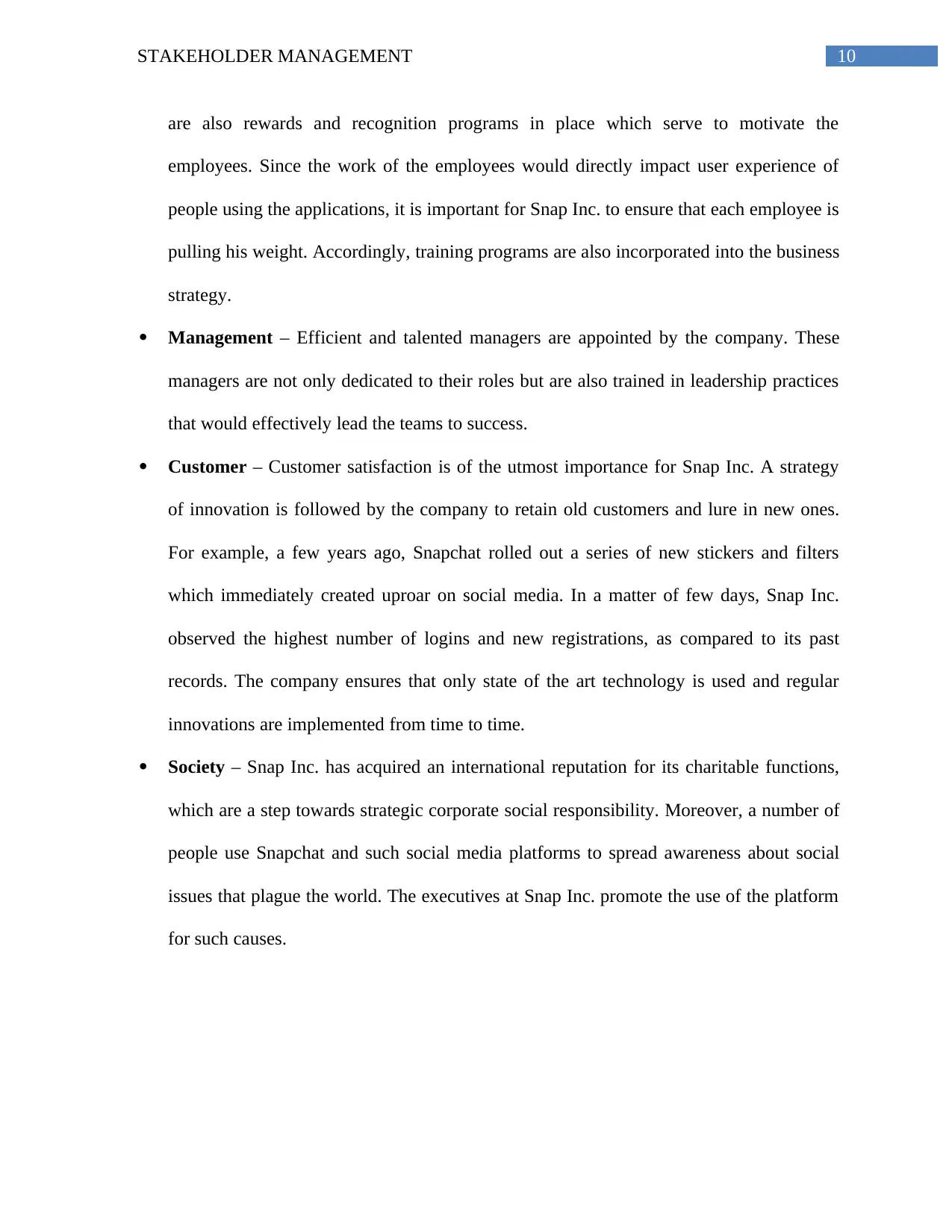
10STAKEHOLDER MANAGEMENT
are also rewards and recognition programs in place which serve to motivate the
employees. Since the work of the employees would directly impact user experience of
people using the applications, it is important for Snap Inc. to ensure that each employee is
pulling his weight. Accordingly, training programs are also incorporated into the business
strategy.
Management – Efficient and talented managers are appointed by the company. These
managers are not only dedicated to their roles but are also trained in leadership practices
that would effectively lead the teams to success.
Customer – Customer satisfaction is of the utmost importance for Snap Inc. A strategy
of innovation is followed by the company to retain old customers and lure in new ones.
For example, a few years ago, Snapchat rolled out a series of new stickers and filters
which immediately created uproar on social media. In a matter of few days, Snap Inc.
observed the highest number of logins and new registrations, as compared to its past
records. The company ensures that only state of the art technology is used and regular
innovations are implemented from time to time.
Society – Snap Inc. has acquired an international reputation for its charitable functions,
which are a step towards strategic corporate social responsibility. Moreover, a number of
people use Snapchat and such social media platforms to spread awareness about social
issues that plague the world. The executives at Snap Inc. promote the use of the platform
for such causes.
are also rewards and recognition programs in place which serve to motivate the
employees. Since the work of the employees would directly impact user experience of
people using the applications, it is important for Snap Inc. to ensure that each employee is
pulling his weight. Accordingly, training programs are also incorporated into the business
strategy.
Management – Efficient and talented managers are appointed by the company. These
managers are not only dedicated to their roles but are also trained in leadership practices
that would effectively lead the teams to success.
Customer – Customer satisfaction is of the utmost importance for Snap Inc. A strategy
of innovation is followed by the company to retain old customers and lure in new ones.
For example, a few years ago, Snapchat rolled out a series of new stickers and filters
which immediately created uproar on social media. In a matter of few days, Snap Inc.
observed the highest number of logins and new registrations, as compared to its past
records. The company ensures that only state of the art technology is used and regular
innovations are implemented from time to time.
Society – Snap Inc. has acquired an international reputation for its charitable functions,
which are a step towards strategic corporate social responsibility. Moreover, a number of
people use Snapchat and such social media platforms to spread awareness about social
issues that plague the world. The executives at Snap Inc. promote the use of the platform
for such causes.
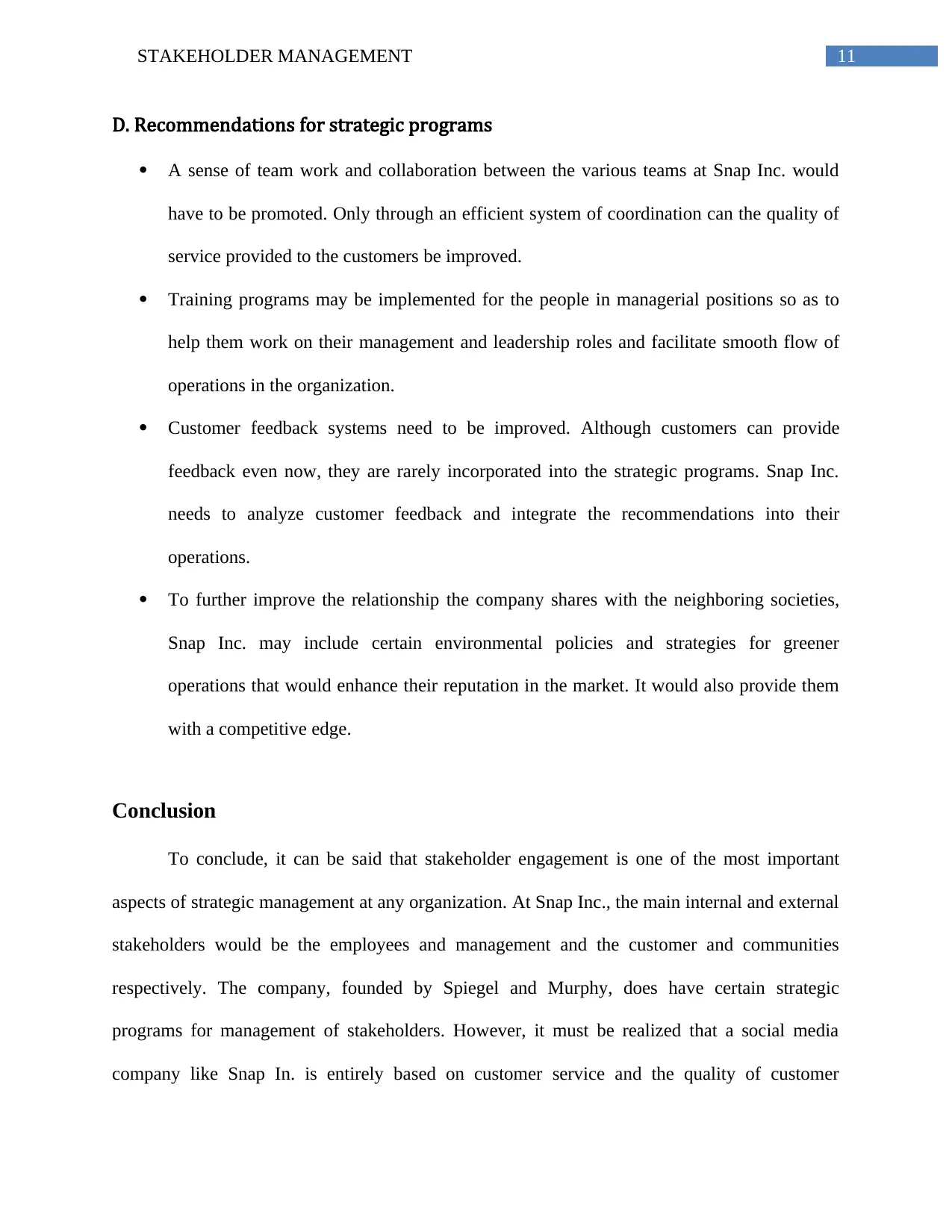
11STAKEHOLDER MANAGEMENT
D. Recommendations for strategic programs
A sense of team work and collaboration between the various teams at Snap Inc. would
have to be promoted. Only through an efficient system of coordination can the quality of
service provided to the customers be improved.
Training programs may be implemented for the people in managerial positions so as to
help them work on their management and leadership roles and facilitate smooth flow of
operations in the organization.
Customer feedback systems need to be improved. Although customers can provide
feedback even now, they are rarely incorporated into the strategic programs. Snap Inc.
needs to analyze customer feedback and integrate the recommendations into their
operations.
To further improve the relationship the company shares with the neighboring societies,
Snap Inc. may include certain environmental policies and strategies for greener
operations that would enhance their reputation in the market. It would also provide them
with a competitive edge.
Conclusion
To conclude, it can be said that stakeholder engagement is one of the most important
aspects of strategic management at any organization. At Snap Inc., the main internal and external
stakeholders would be the employees and management and the customer and communities
respectively. The company, founded by Spiegel and Murphy, does have certain strategic
programs for management of stakeholders. However, it must be realized that a social media
company like Snap In. is entirely based on customer service and the quality of customer
D. Recommendations for strategic programs
A sense of team work and collaboration between the various teams at Snap Inc. would
have to be promoted. Only through an efficient system of coordination can the quality of
service provided to the customers be improved.
Training programs may be implemented for the people in managerial positions so as to
help them work on their management and leadership roles and facilitate smooth flow of
operations in the organization.
Customer feedback systems need to be improved. Although customers can provide
feedback even now, they are rarely incorporated into the strategic programs. Snap Inc.
needs to analyze customer feedback and integrate the recommendations into their
operations.
To further improve the relationship the company shares with the neighboring societies,
Snap Inc. may include certain environmental policies and strategies for greener
operations that would enhance their reputation in the market. It would also provide them
with a competitive edge.
Conclusion
To conclude, it can be said that stakeholder engagement is one of the most important
aspects of strategic management at any organization. At Snap Inc., the main internal and external
stakeholders would be the employees and management and the customer and communities
respectively. The company, founded by Spiegel and Murphy, does have certain strategic
programs for management of stakeholders. However, it must be realized that a social media
company like Snap In. is entirely based on customer service and the quality of customer
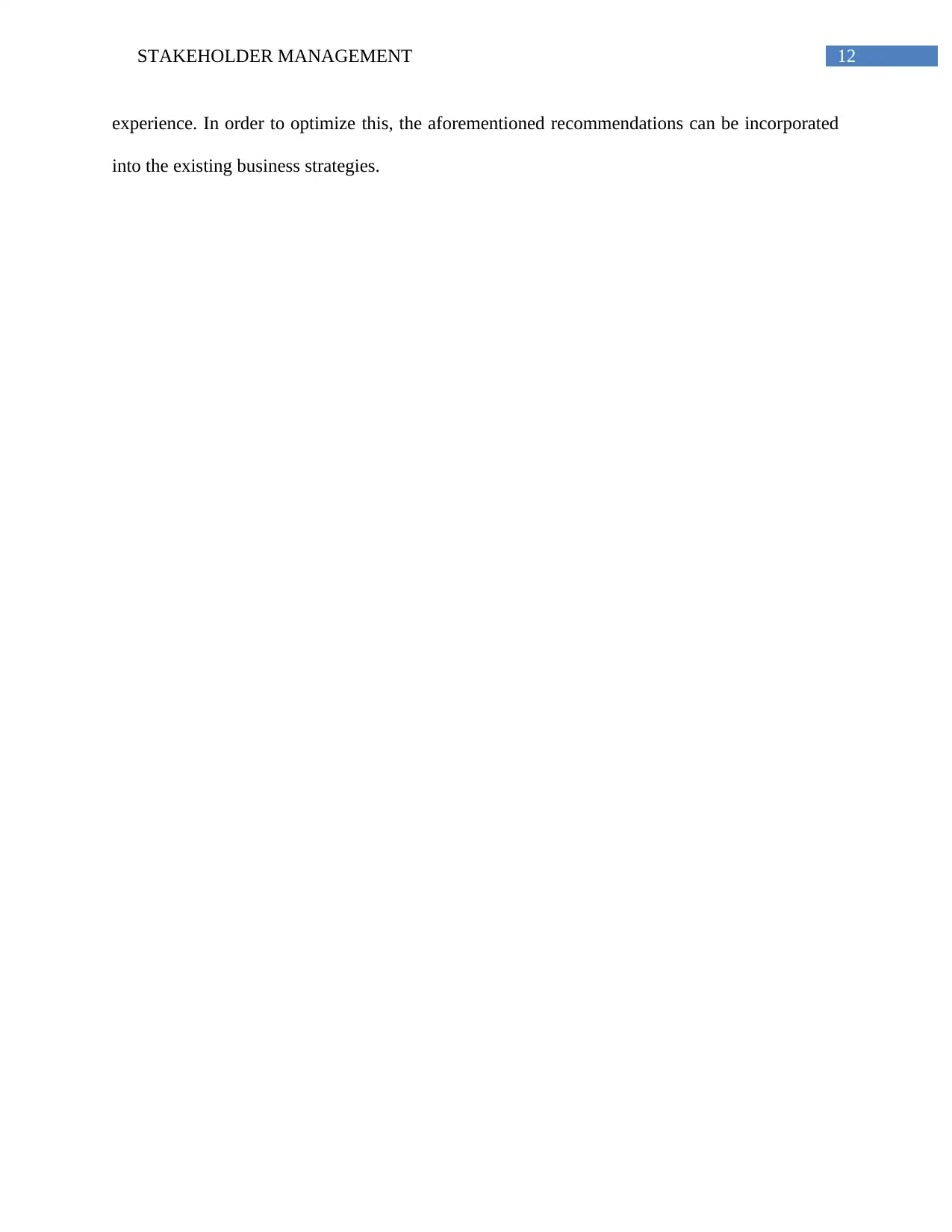
12STAKEHOLDER MANAGEMENT
experience. In order to optimize this, the aforementioned recommendations can be incorporated
into the existing business strategies.
experience. In order to optimize this, the aforementioned recommendations can be incorporated
into the existing business strategies.
Paraphrase This Document
Need a fresh take? Get an instant paraphrase of this document with our AI Paraphraser
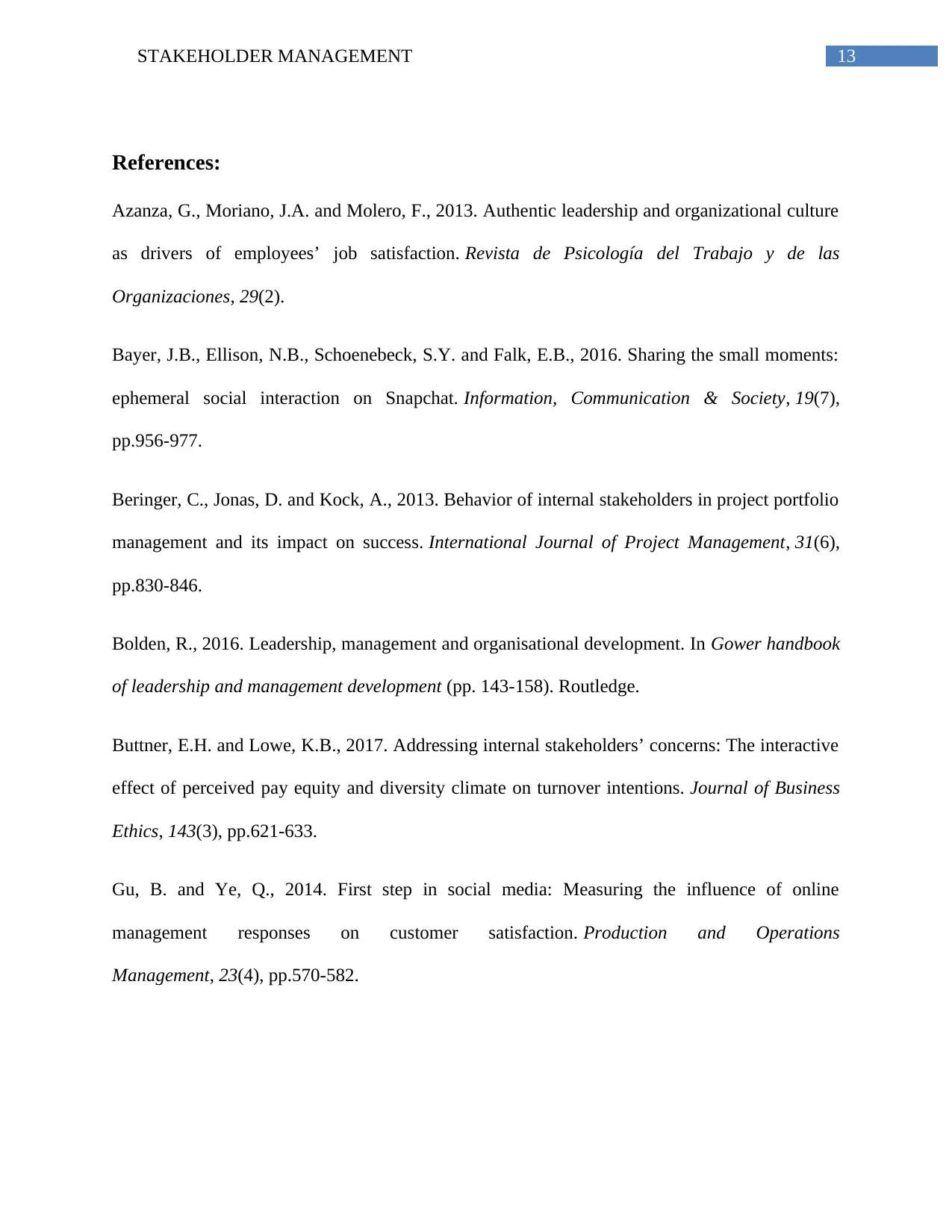
13STAKEHOLDER MANAGEMENT
References:
Azanza, G., Moriano, J.A. and Molero, F., 2013. Authentic leadership and organizational culture
as drivers of employees’ job satisfaction. Revista de Psicología del Trabajo y de las
Organizaciones, 29(2).
Bayer, J.B., Ellison, N.B., Schoenebeck, S.Y. and Falk, E.B., 2016. Sharing the small moments:
ephemeral social interaction on Snapchat. Information, Communication & Society, 19(7),
pp.956-977.
Beringer, C., Jonas, D. and Kock, A., 2013. Behavior of internal stakeholders in project portfolio
management and its impact on success. International Journal of Project Management, 31(6),
pp.830-846.
Bolden, R., 2016. Leadership, management and organisational development. In Gower handbook
of leadership and management development (pp. 143-158). Routledge.
Buttner, E.H. and Lowe, K.B., 2017. Addressing internal stakeholders’ concerns: The interactive
effect of perceived pay equity and diversity climate on turnover intentions. Journal of Business
Ethics, 143(3), pp.621-633.
Gu, B. and Ye, Q., 2014. First step in social media: Measuring the influence of online
management responses on customer satisfaction. Production and Operations
Management, 23(4), pp.570-582.
References:
Azanza, G., Moriano, J.A. and Molero, F., 2013. Authentic leadership and organizational culture
as drivers of employees’ job satisfaction. Revista de Psicología del Trabajo y de las
Organizaciones, 29(2).
Bayer, J.B., Ellison, N.B., Schoenebeck, S.Y. and Falk, E.B., 2016. Sharing the small moments:
ephemeral social interaction on Snapchat. Information, Communication & Society, 19(7),
pp.956-977.
Beringer, C., Jonas, D. and Kock, A., 2013. Behavior of internal stakeholders in project portfolio
management and its impact on success. International Journal of Project Management, 31(6),
pp.830-846.
Bolden, R., 2016. Leadership, management and organisational development. In Gower handbook
of leadership and management development (pp. 143-158). Routledge.
Buttner, E.H. and Lowe, K.B., 2017. Addressing internal stakeholders’ concerns: The interactive
effect of perceived pay equity and diversity climate on turnover intentions. Journal of Business
Ethics, 143(3), pp.621-633.
Gu, B. and Ye, Q., 2014. First step in social media: Measuring the influence of online
management responses on customer satisfaction. Production and Operations
Management, 23(4), pp.570-582.
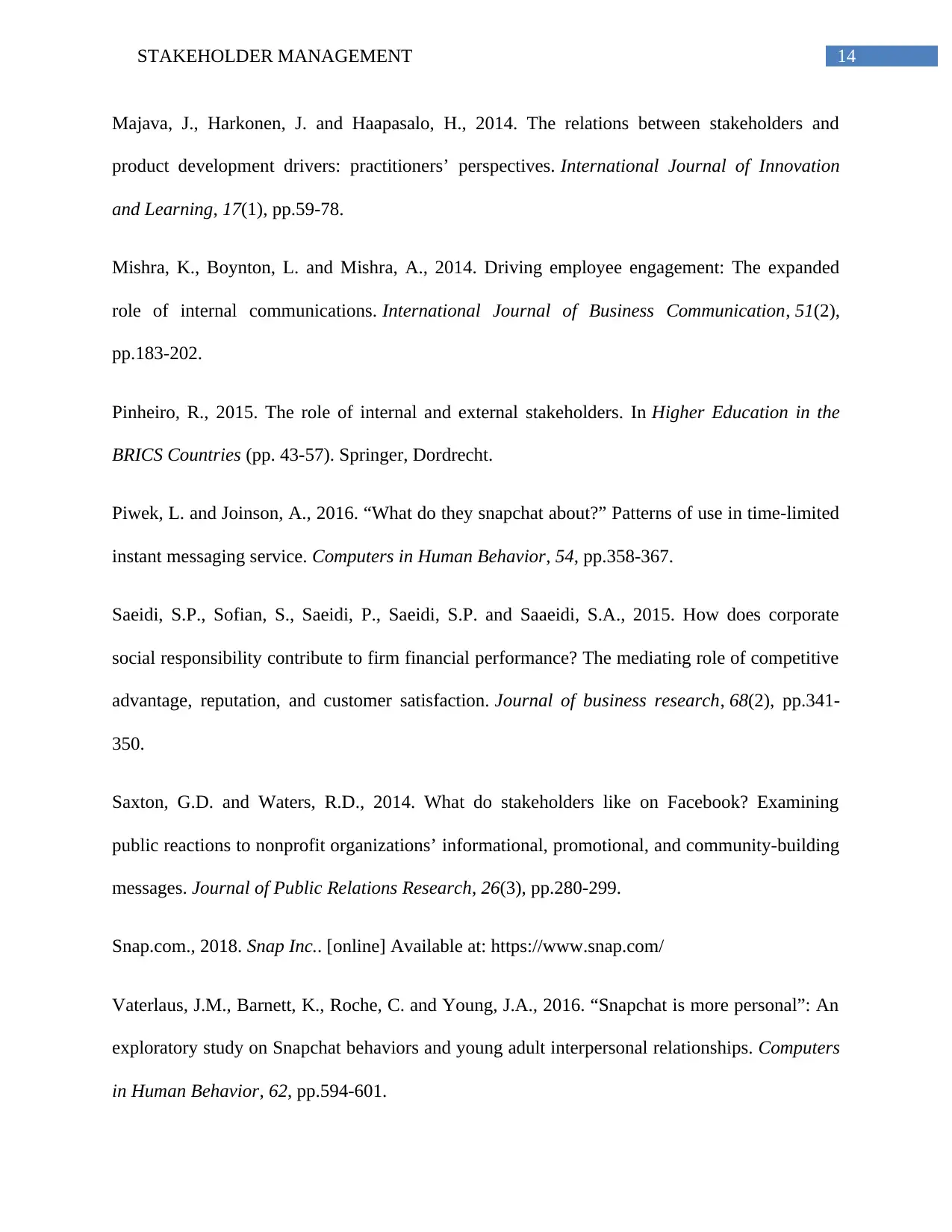
14STAKEHOLDER MANAGEMENT
Majava, J., Harkonen, J. and Haapasalo, H., 2014. The relations between stakeholders and
product development drivers: practitioners’ perspectives. International Journal of Innovation
and Learning, 17(1), pp.59-78.
Mishra, K., Boynton, L. and Mishra, A., 2014. Driving employee engagement: The expanded
role of internal communications. International Journal of Business Communication, 51(2),
pp.183-202.
Pinheiro, R., 2015. The role of internal and external stakeholders. In Higher Education in the
BRICS Countries (pp. 43-57). Springer, Dordrecht.
Piwek, L. and Joinson, A., 2016. “What do they snapchat about?” Patterns of use in time-limited
instant messaging service. Computers in Human Behavior, 54, pp.358-367.
Saeidi, S.P., Sofian, S., Saeidi, P., Saeidi, S.P. and Saaeidi, S.A., 2015. How does corporate
social responsibility contribute to firm financial performance? The mediating role of competitive
advantage, reputation, and customer satisfaction. Journal of business research, 68(2), pp.341-
350.
Saxton, G.D. and Waters, R.D., 2014. What do stakeholders like on Facebook? Examining
public reactions to nonprofit organizations’ informational, promotional, and community-building
messages. Journal of Public Relations Research, 26(3), pp.280-299.
Snap.com., 2018. Snap Inc.. [online] Available at: https://www.snap.com/
Vaterlaus, J.M., Barnett, K., Roche, C. and Young, J.A., 2016. “Snapchat is more personal”: An
exploratory study on Snapchat behaviors and young adult interpersonal relationships. Computers
in Human Behavior, 62, pp.594-601.
Majava, J., Harkonen, J. and Haapasalo, H., 2014. The relations between stakeholders and
product development drivers: practitioners’ perspectives. International Journal of Innovation
and Learning, 17(1), pp.59-78.
Mishra, K., Boynton, L. and Mishra, A., 2014. Driving employee engagement: The expanded
role of internal communications. International Journal of Business Communication, 51(2),
pp.183-202.
Pinheiro, R., 2015. The role of internal and external stakeholders. In Higher Education in the
BRICS Countries (pp. 43-57). Springer, Dordrecht.
Piwek, L. and Joinson, A., 2016. “What do they snapchat about?” Patterns of use in time-limited
instant messaging service. Computers in Human Behavior, 54, pp.358-367.
Saeidi, S.P., Sofian, S., Saeidi, P., Saeidi, S.P. and Saaeidi, S.A., 2015. How does corporate
social responsibility contribute to firm financial performance? The mediating role of competitive
advantage, reputation, and customer satisfaction. Journal of business research, 68(2), pp.341-
350.
Saxton, G.D. and Waters, R.D., 2014. What do stakeholders like on Facebook? Examining
public reactions to nonprofit organizations’ informational, promotional, and community-building
messages. Journal of Public Relations Research, 26(3), pp.280-299.
Snap.com., 2018. Snap Inc.. [online] Available at: https://www.snap.com/
Vaterlaus, J.M., Barnett, K., Roche, C. and Young, J.A., 2016. “Snapchat is more personal”: An
exploratory study on Snapchat behaviors and young adult interpersonal relationships. Computers
in Human Behavior, 62, pp.594-601.

15STAKEHOLDER MANAGEMENT
Verbeke, A. and Tung, V., 2013. The future of stakeholder management theory: A temporal
perspective. Journal of Business Ethics, 112(3), pp.529-543.
Verbeke, A. and Tung, V., 2013. The future of stakeholder management theory: A temporal
perspective. Journal of Business Ethics, 112(3), pp.529-543.
1 out of 16
Related Documents
Your All-in-One AI-Powered Toolkit for Academic Success.
+13062052269
info@desklib.com
Available 24*7 on WhatsApp / Email
![[object Object]](/_next/static/media/star-bottom.7253800d.svg)
Unlock your academic potential
© 2024 | Zucol Services PVT LTD | All rights reserved.





